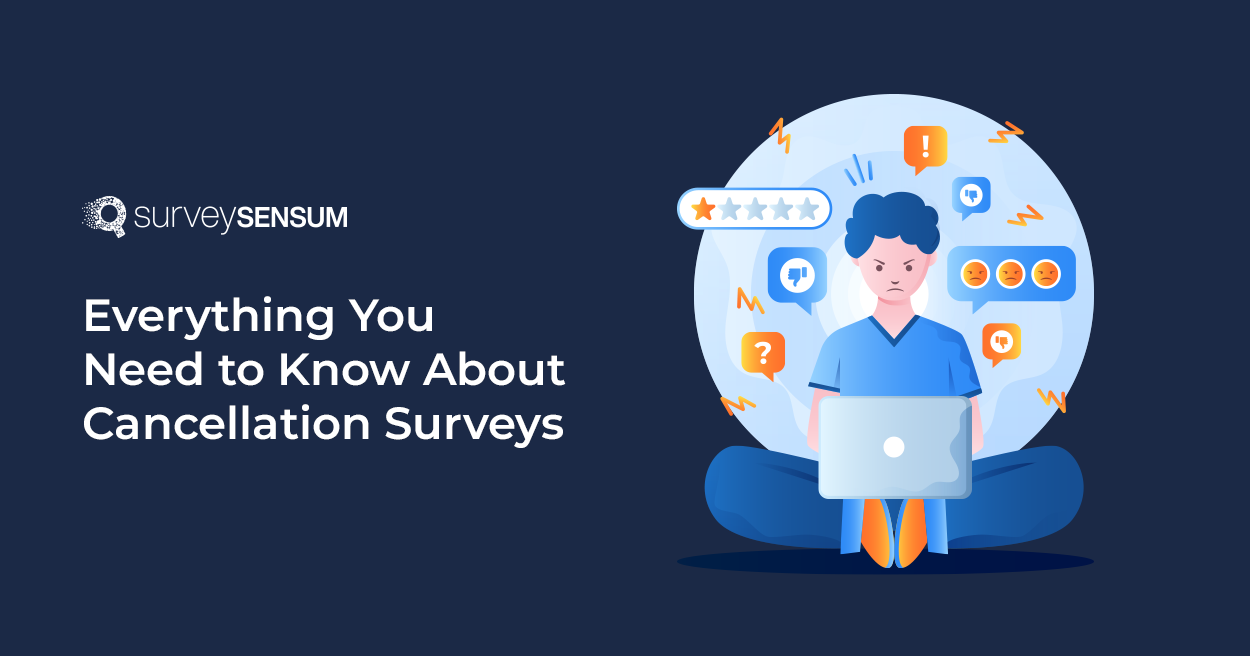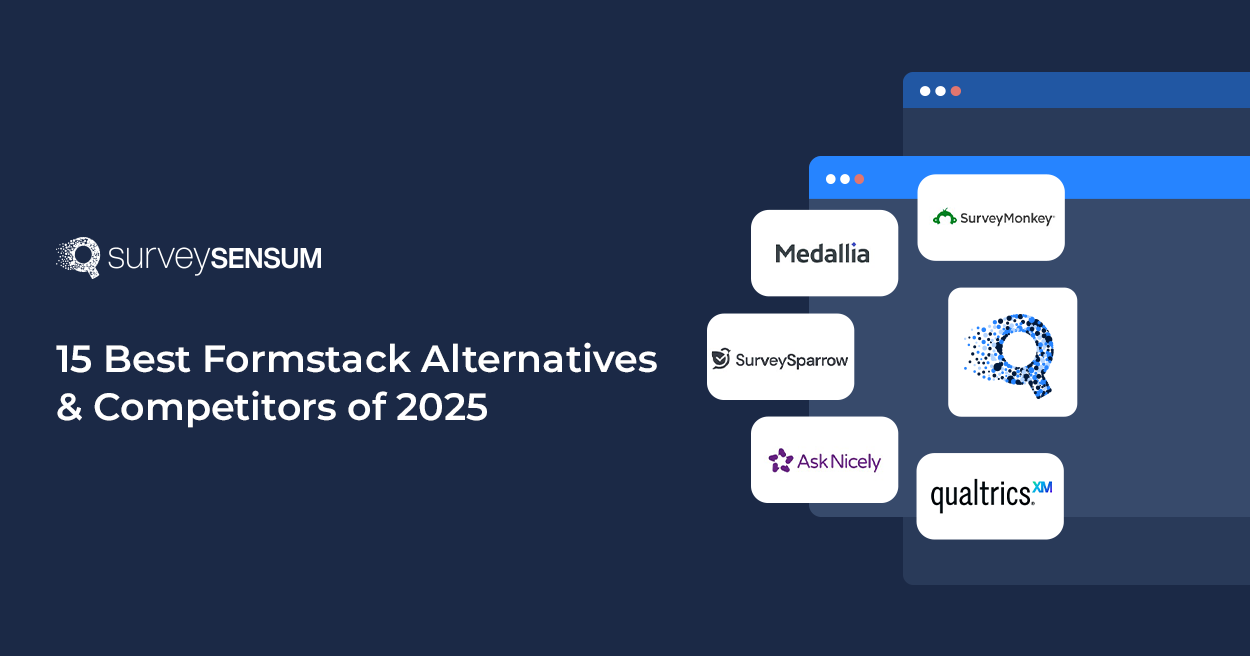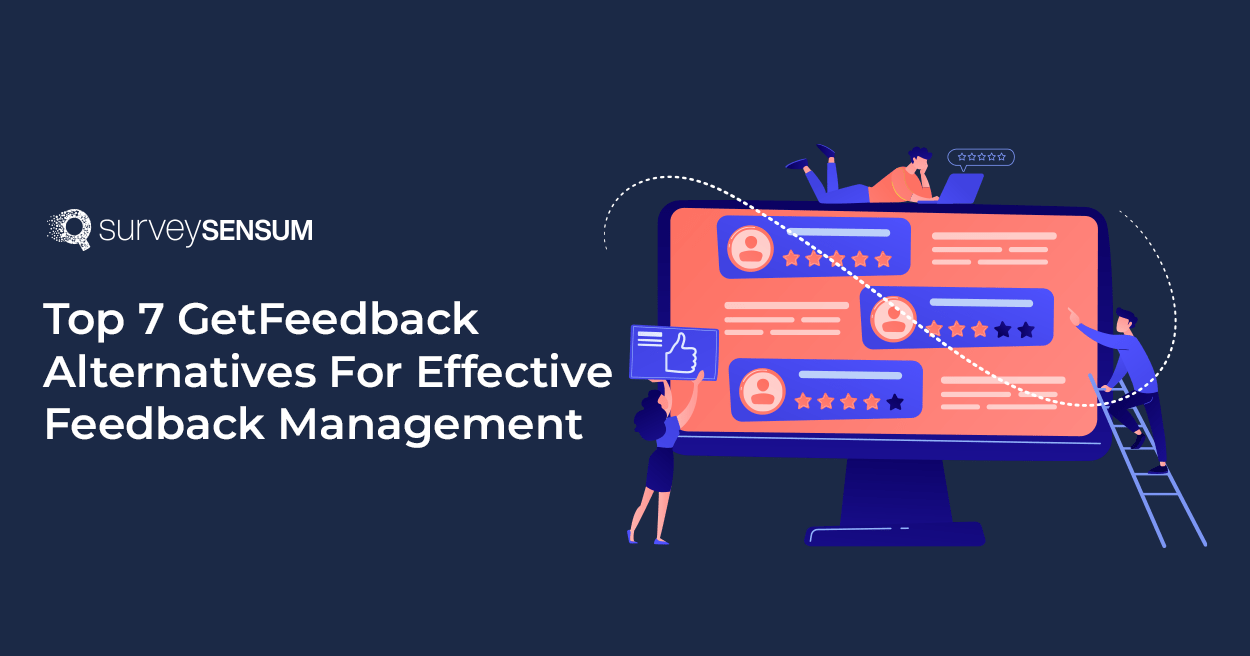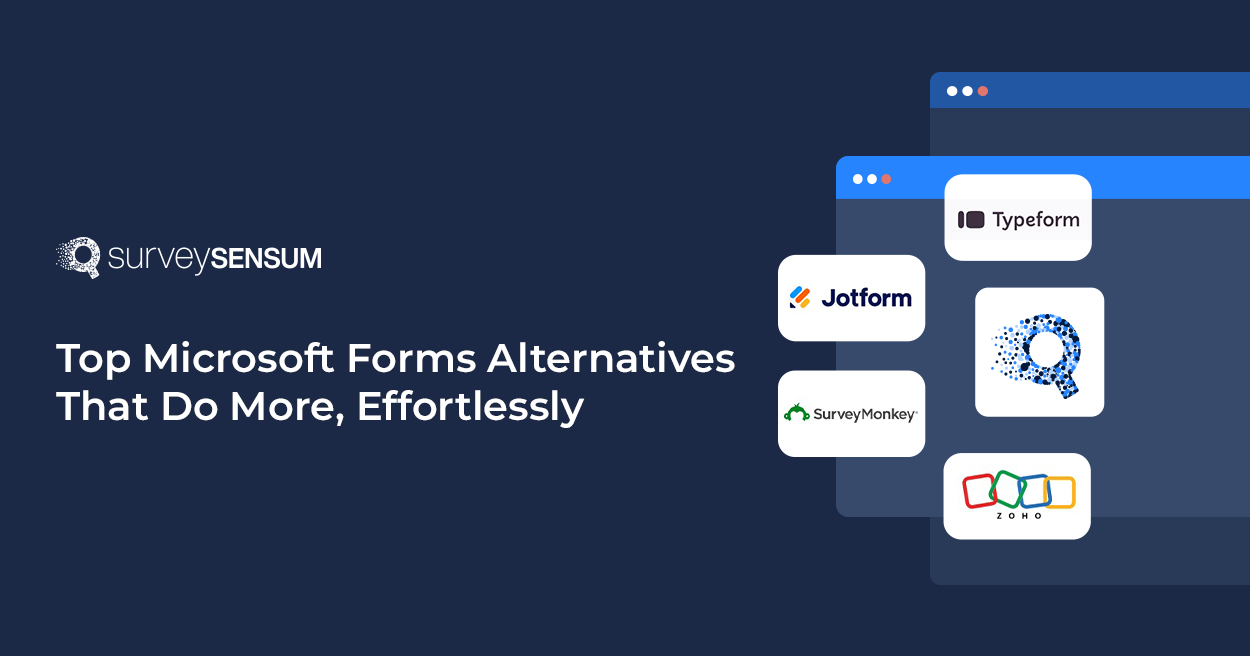
Well, this has been a challenge faced by many companies. After putting so much effort into getting them onboard, they leave. Yes, this hurts like a breakup!
But fret not; there is one thing you can do!
Launch cancellation surveys – a smart way to find out why customers say goodbye, but in a friendly and helpful way.
So, what is a cancellation survey?
A cancellation survey is a set of questions sent to users to determine why your customers are leaving. The feedback from these surveys will help you prevent customer churn or resolve the issue from the core so that no one else jumps ship for the same reason.
Ideally, this survey will immediately pop up when the user clicks the cancel button.
It usually starts with a simple question: “Why are you leaving?” But it doesn’t end there – businesses listen and come up with new ideas to convince customers to stay. It’s like changing a “see ya” into a “let’s give it another try.”
But, why bother with all this? Well, research says that businesses can win back 70% of dissatisfied customers when their issues are resolved.
Now, you might wonder, “How can cancellation surveys save your customers from leaving?”
Let’s talk about that and more in this blog – from using them to reduce customer churn to asking the perfect survey questions. We’ll also discuss how you can harness the power of a robust customer feedback platform to create and analyze effective cancellation surveys.
But first, you need to know the amazing benefits of this survey.
So, let’s get started, shall we?
Benefits of Using Cancellation Surveys
Customer feedback gathered from cancellation surveys can be a game-changer for your business, bringing many benefits beyond just understanding why customers leave. Let’s explore the key advantages of incorporating cancellation surveys into your strategy:
1. Pinpointing Key Improvement Areas: Ever wondered why customers leave? With cancellation surveys, you can identify specific pain points in your product, pricing, or customer service that drive churn. It’s like having a map of the treasure of improvement opportunities.
2. Understanding Customer Needs and Preferences: Get real, actionable insights into what they value and how they use your service. This isn’t just data; it’s the golden key to customer satisfaction. Happy customers stick around, right?
3. Reducing Churn and Improving Retention: Knowledge is power, my friend. Armed with insights from cancellation surveys, you can make strategic changes to prevent future cancellations.
4. Winning Back Lost Customers: Do you also wish to have a second chance? Well, here it is. With personalized incentives or targeted improvements based on specific feedback, you can win back customers who slipped through your fingers.
5. Staying Ahead of the Competition: Cancellation surveys aren’t just about your customers; they’re about your competitors too. By understanding why customers choose a competitor, you can identify specific features, pricing models, or service aspects that attract them.
You see, these cancellation surveys can be beneficial for your business! Launch customer cancellation survey with SurveySensum!
Now, let’s look at some of the best practices for gathering cancellation surveys.
Cancellation Survey Best Practices: Crafting User-Friendly Feedback Loops
Crafting a cancellation survey that customers not only complete but also find valuable is key to understanding their reasons and improving your services. Here are some user-friendly cancellation survey best practices that can make a significant difference
1. In-App Surveys at Cancellation:

Trigger surveys immediately after a cancellation request to capture real-time feedback. Furthermore, an in-app customer cancellation survey simplifies the process of winning them back by increasing the chances of participation and ensuring that customers recall their experience accurately.
2. Opt-Out Option:
Respect your customers’ choices! Provide an opt-out option for those who prefer not to participate in the survey. This shows consideration for their time and preference, contributing to a positive customer experience.
3. A/B Test Survey Types:
Experiment with different survey formats to find the most effective approach. A/B testing can help you discover the survey type that resonates best with your audience, whether it’s a simple or more interactive format.
4. Keep it short:

Avoid overwhelming customers with lengthy surveys. Keep questions concise and to the point, making it easy for users to breeze through the survey without feeling burdened.
5. Use a mix of question types:

Combine multiple-choice, open-ended, and Likert scale questions for a comprehensive view of user feedback. This makes the survey more engaging and provides you with a richer set of data to analyze.
6. Ask specific and relevant questions:
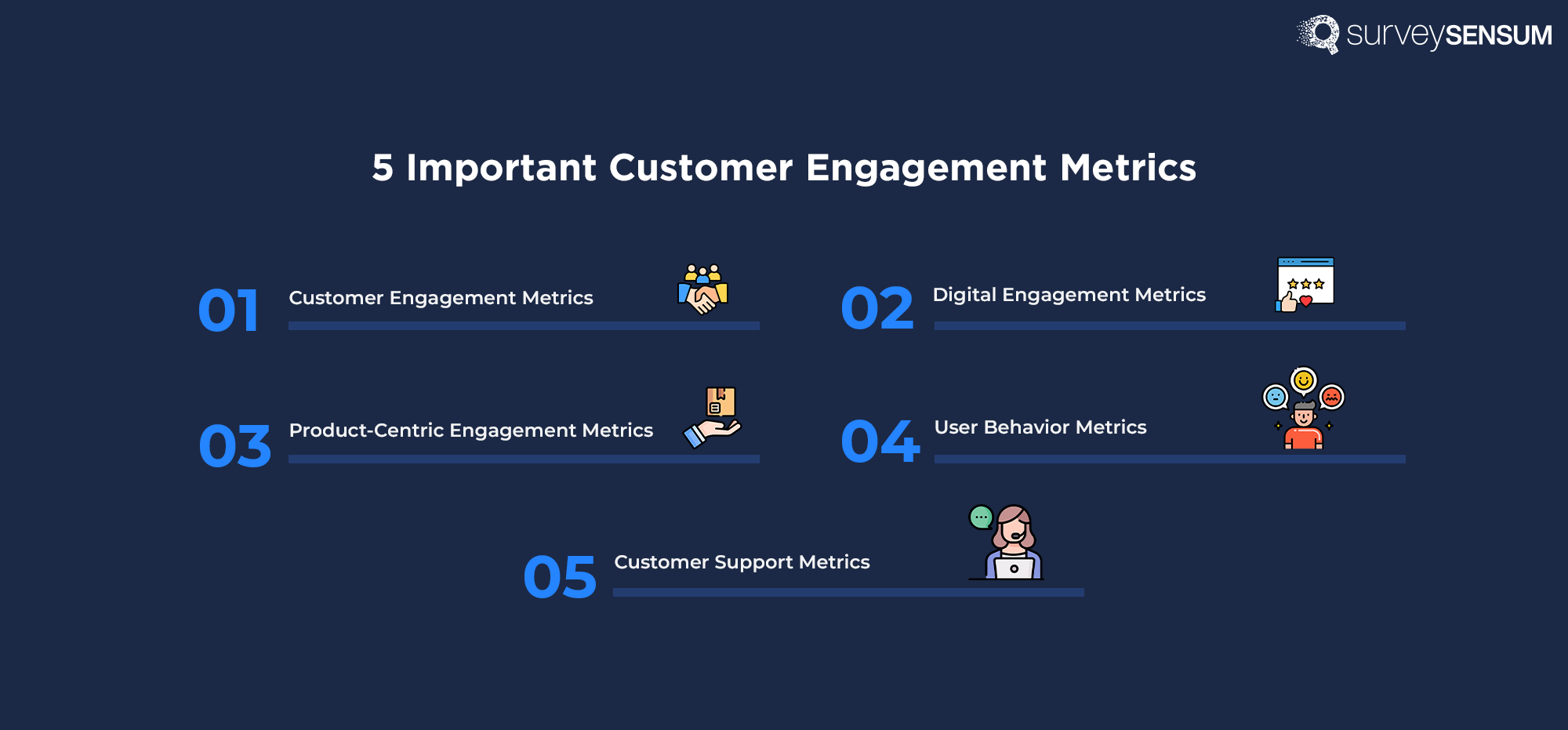
Tailor questions to the specific service and potential reasons for cancellation. By asking targeted questions, you’re more likely to receive insightful responses that can guide your efforts to enhance customer satisfaction.
7. Focus on Actionable Feedback:
Ensure your questions guide users toward providing actionable feedback. Instead of vague inquiries, ask about specific features, experiences, or aspects of the service that can be addressed and improved upon. This targeted approach facilitates strategic decision-making.
8. Make it Easy to Complete:
Implement a user-friendly survey interface that is easy to navigate. Additionally, it provides flexibility by allowing users to complete the survey through various channels, including web forms, email links, or even phone interviews. This accommodates diverse user preferences and accessibility.
9. Follow Up with Customers:
Thank them for their feedback and share how you plan to address their concerns. Follow up with an exit interview to gain more valuable insights. Closing the feedback loop is crucial. Express gratitude to users for their input and, more importantly, communicate how their feedback is utilized for improvements.
10. Use a User-Friendly Survey Platform:
Choose a user-friendly survey platform that works well on various devices. Ensure the survey is easy to navigate, enhancing the overall user experience.
11. Timing is Key:
Send the survey at an appropriate time, such as immediately after cancellation, during the cancellation process, or shortly after the end of the billing cycle. Choose a timing that aligns with your service model and customer behavior.
→ Learn the Best Time to Send the Survey
Send Surveys at the right time with SurveySensum.
12. Send Win-Back Emails to Churned Users:
Don’t stop at feedback – leverage the insights gained to re-engage with churned users. Implement win-back emails that offer targeted incentives or improvements based on their reasons for leaving. This personalized approach showcases a commitment to addressing concerns and can be a powerful strategy for customer retention.
For example, if a customer has a pricing issue, send them an email with a discount. If they say they’re trying a different product, you can ask them about it. And if they mention closing their business, you can email them your services will be here for them if needed. These messages help keep the talk going and allow you to help your customers even more.
The benefits of cancellation surveys are quite a lot, aren’t they? But, you gotta know the right questions to ask your customers.
Cancellation Survey Questions
Crafting effective cancellation survey questions is essential to gather valuable insights from users who decide to cancel your service. Here’s a set of thoughtful questions to include in your cancellation survey:
1. Reason for Cancellation:
What made you cancel your subscription?
Purpose: Your focus here is uncovering the primary reason behind your cancellation. This open-ended question allows you to express your specific concerns or motivations, providing a qualitative understanding of your decision.
2. Prevention Measures:
Is there something specific we could have done to retain you as a subscriber?
Purpose: Using a direct approach, this question seeks actionable customer insights helping you understand their expectations. Asking if there were alternative actions you could have taken opens the door for valuable suggestions or highlights areas where improvements could have influenced their decision to stay.
3. Consideration of Alternatives:
Did you explore other subscription alternatives before canceling? If yes, which ones?
Purpose: Understanding if you explored alternatives offers insight into your product’s competitive landscape. This question helps identify specific competitors or alternative solutions that might appeal more to you, contributing to strategic market positioning.
4. Missing Features:
Were there any product features you expected but did not find?
Purpose: Delving into specific product expectations, this question encourages customers to reveal anticipated features that may have been absent in your offering. The insights gathered here inform future product development and enhancement strategies.
5. Future Usage Likelihood:
On a scale of 1 to 10, how likely are you to reconsider using our product in the future? (1 being not likely at all, 10 being extremely likely)
Purpose: Quantifying the likelihood of the customer returning in the future is the aim here. The numerical scale provides a measurable metric, making it easier to gauge overall sentiment and track changes in customer’s willingness to reconsider your product.
But just asking the right question is not enough! Choosing the perfect moment for sending these surveys is equally crucial. Let’s find out the right moment for sending cancellation surveys.
Choosing the Perfect Moment for Cancellation Surveys: Timing Tactics for Maximum Impact
Deciding when to roll out cancellation surveys is a strategic move that can make a real difference in gaining valuable insights and bringing back customers who have decided to part ways.
Let’s break down two primary options – in-app, real-time surveys, and email surveys after cancellation – along with their pros and cons:
1. In-App, Real-time Surveys:

Pros:
- Higher response rate: Catch users in the moment when the experience is fresh, leading to more immediate feedback.
- Targeted incentives or solutions: Real-time surveys allow for quick responses, making it possible to offer immediate solutions or incentives to increase retention.
- Reduces friction: Since users are already in the cancellation process, adding a survey here reduces friction and encourages participation.
Cons:
- Biased responses: Users may be frustrated or emotional during cancellation, which could lead to biased responses that don’t reflect their overall experience accurately.
- Limited space for detailed responses: The real-time nature of in-app surveys may restrict users from providing detailed or nuanced feedback.
- Not applicable for all platforms/services: In-app surveys might not suit all platforms or services, depending on the nature of the business.
Launch In-app surveys with SurveySensum for FREE!
2. Email Surveys After Cancellation:

Pros:
- Allows for calmer reflections: Users have time to reflect calmly, leading to more thoughtful and considered responses that provide deeper insights.
- Gathers data from all users: This approach captures feedback from all users, including those who cancel offline or through other channels.
- More space for detailed feedback: Email surveys provide ample space for open-ended questions, enabling users to share detailed feedback and experiences.
Cons:
- Lower response rate: Users may be less likely to respond to an email survey than an in-app survey, potentially leading to a lower overall survey response rate.
- Less immediate impact on potential win-backs: The delay between cancellation and survey response may reduce the immediate impact.
- Requires capturing cancellation data and sending personalized emails: Implementing email surveys involves a system for capturing and sending personalized emails, adding a layer of complexity.
Choosing the Right Timing for Your Goals:
- For high response rates and quick action: If your main goal is immediate feedback and the potential for quick win-backs, in-app, real-time surveys are the way to go.
- For in-depth feedback and potential win-backs: If you aim to gather more thoughtful and detailed feedback, allowing for calmer reflections and potential win-back strategies, email surveys after cancellation are the better option.
You must have figured out why customers unsubscribe from your business by now. Not yet? Let’s discover why customers churn and how you can make them stay!
Exploring Why Customers Say Goodbye and How to Bring Them Back
Alright, let’s dive into the reasons customers decide to part ways with our services and some practical steps to win them back:
1. Product/Service Issues:
- Lack of Features or Functionality: Regular user feedback sessions help identify and prioritize missing features. Let’s make sure we’re continuously enhancing our offering.
- Poor Performance or Bugs: Implementing robust testing processes and regular updates will ensure a smoother user experience without pesky bugs.
- Difficulty of Use or Complexity: Simplifying interfaces and providing clear instructions can simplify the user experience.
- Incompatibility with Other Tools or Devices: Regular updates and partnerships with popular tools ensure seamless integration.
2. Pricing Concerns:
- Cost Exceeding Perceived Value: Communicating the value proposition effectively helps justify the cost, and sharing success stories reinforces the benefits.
- Lack of Transparency or Confusing Pricing Models: Simplify pricing models and offer transparent breakdowns to avoid confusion.
- Hidden Fees or Charges: Transparency is key. Ensure all fees are communicated upfront, leaving no room for surprises.
3. Better Value Available from Competitors:
- Customers perceive that competitors offer a better product or service: Regularly analyze the competition, enhance unique selling points, and communicate these effectively.
- Consider adjusting pricing or adding value to match or exceed competitors: Keep a pulse on the market and make strategic adjustments to stay competitive.
4. Customer Experience Problems:
- Poor Customer Service or Responsiveness: Invest in responsive and helpful customer support to enhance overall satisfaction.
- Lack of Communication or Transparency: Clear communication channels for updates and changes contribute to a positive customer experience.
- Difficulty in Canceling or Managing the Service: Simplify processes and provide clear instructions to make user interactions hassle-free.
- Unresponsive to Customer Feedback or Suggestions: Actively engage with and implement customer feedback, showing users their input is valued.
5. Lifestyle or Usage Changes:
- No Longer Need the Service Due to Life Changes: Offer flexible subscription plans to accommodate changing circumstances.
- Reduced Usage or Lack of Time to Use the Service: Implement loyalty programs or incentives to encourage ongoing usage.
- Finding Alternative Solutions or Switching to Competitors: Regularly communicate with users to understand evolving needs and adjust marketing strategies accordingly.
6. Unmet Expectations:
- Customers had expectations not fulfilled by the service: Communicate product capabilities and limitations and set realistic expectations during onboarding.
- Regularly gather customer feedback to understand and address evolving expectations: Create a continuous feedback loop to stay informed about customer expectations and make necessary improvements.
So, keeping communication open, addressing issues promptly, and continuously refining the service based on customer feedback should be our playbook for winning back those who’ve decided to take a break.
Now, let’s have a look at what some of the renowned CX experts have to say about the cancellation surveys.
What do Leaders say about gaining insight from customers canceling service?
Introduction
During a recent discussion on the Customer Experience Question of the Day (CXQOTD), Jeremy Watkin from Number Barn shared his insights on learning from customers who cancel their service.
To understand their experiences better, he conducted a customer effort survey. The responses revealed a spectrum of feelings, with some customers expressing dissatisfaction with the process, while others indicated a possibility of returning in the future.
Jeremy proposed three strategies for extracting insights from customers who have decided to cancel their service:
- Surveys: Choose a strategic point in the customer journey to understand the reasons behind cancellations. This helps identify whether customers are upset, leaving due to other circumstances, or likely to return.
- Cancellation Reason Prompt: Requesting a reason for cancellation when customers initiate the process. However, Jeremy notes the importance of minimizing friction in their experience.
- Speech Analytics: Utilizing text analytics software to detect keywords like “cancel” or expressions indicating dissatisfaction. This tool proves invaluable in pinpointing potential pain points in the customer experience.
Leaders in the field offer their insights:
- Shep Hyken – “Ask them! Listen to them! Act on the information. If many customers are canceling for the same reason, make a change! That’s unless you like customer churn!”
- Tanuj Diwan, Co-Founder at SurveySensum – “My responses from a SAAS perspective: We send an email after a cancellation or lost deal. The email says even though it did not work out, we would love to understand what went wrong so that we’re ready for you in the future. Can you spare 10 minutes? The best feedback we ever receive.”
- Josh Varga – “Ask them, whether via a follow-up survey or in the moment. If you’re collecting a reason and it’s just chilling in a database, you’re sitting on a gold mine! I think it’s worth adding a small amount of friction (ideally, make it optional) to get this data.” #cxqotd
- Murphy Fraser – “Depends on your product/Customer, but… use your data! Did the Customer never use your offering? What does their support history look like? Where did they come from/what was the motivation that got them to you in the first place? Were you able to deliver value?” #CXQOTD
- Nicholas Zeisler – “Cancellation is an interaction… ergo, you should be looking to learn from it. Regardless of whether the Customer is leaving for lack of a good experience or simply because that’s all they need from you, be curious and look for feedback you can act upon.”
Conclusion
The journey to reduce customer churn is paved with valuable insights, and cancellation surveys emerge as the guiding light. By understanding the reasons behind cancellations, businesses can transform setbacks into opportunities for growth and improvement.
Amplifying your retention efforts becomes even more seamless with a robust customer feedback tool like SurveySensum.
This advanced platform allows you to craft personalized questionnaires, streamlines the survey process, and enhances the analysis of customer feedback. Its advanced features allow businesses to delve deep into the nuances of responses, uncovering patterns and trends that might have gone unnoticed.






